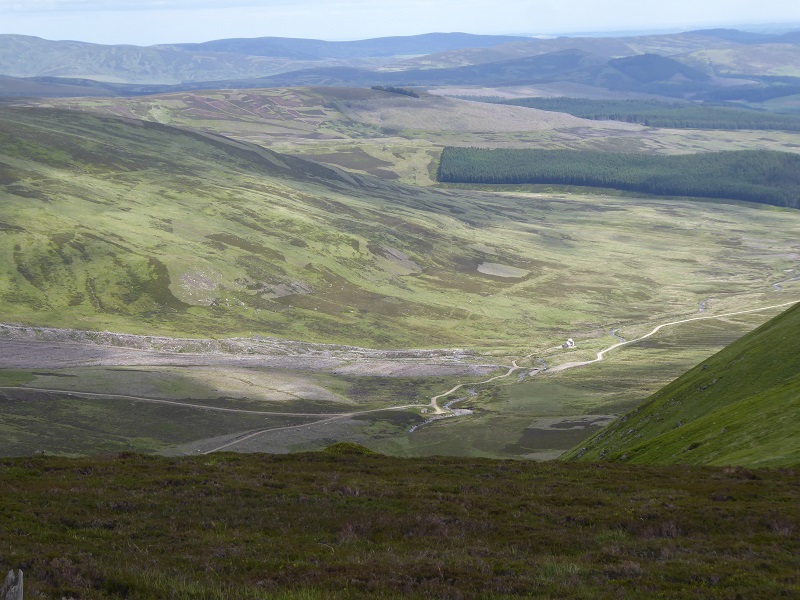
At the start of October, almost a year after they bought the Glen Prosen Estate for £17,555,000, , Forest and Land Scotland (FLS) launched an initial consultation of what to do with the land and buildings under the banner of developing an Angus Glens Land Management Plan (see here).
When I last wrote about Glen Prosen in January (see here) I thought it might take FLS to 12 months to develop a land-management plan. FLS are now saying they expect to take another 12-18 months to do so. What climate and nature emergency? Two weeks ago SEPA’s river level guage at Prosen Bridge recorded the highest water during Storm Babet and some of the people waiting to hear the answer from FLS are living downstream in Brechin (see here).
The online survey, which is open until 12th November, comprises just four short questions, albeit substantive ones: what’s special about the landscape; opportunities; could the land be managed differently; and opportunities for involving people? The open-ended questions are welcome – it encourages thought and I would urge readers to respond – but why has it taken FLS so long to write four sentences?
The scope of the consultation
While prompted by the purchase of Glen Prosen, the consultation is about developing a single land management plan which covers both the new acquisition AND Glen Doll. FLS’s proposal is that once the plan for Glen Prosen and Glen Doll is complete, it will be combined with those for the plantations in “Glen Isla” (its actually Glen Finlet) and Glen Markie, to form one Angus Glens plan.
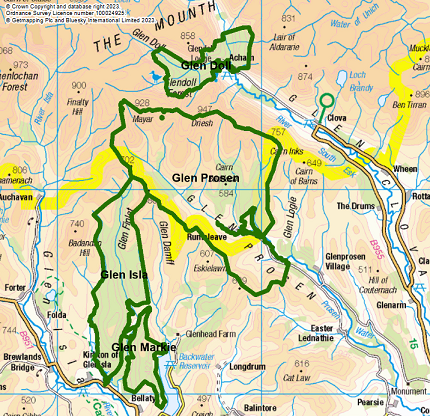
The consultation states that the plan for “Glen Isla” and Glen Markie was consulted on earlier this year but says nothing else about it and provides no links (see here– the plan is still awaiting final approval)
Glen Doll, which was planted by the Forestry Commission in the 1950s, has a Forest Design Plan in place dating back to 2009 (see here). There is no reference to this in the consultation or the fact that some of the Glen Doll documentation has been updated recently (see here).
It is unclear what the benefits of combining all these plans together might be, except possibly deer control. The landholdings lie in four different glens, two different catchments and none of the “Glen Isla” plantations are in the National Park. While geographically close, by road its a different matter..
The Glen Isla plantations are managed solely for commercial timber production. The draft land management plan explained significant parts of the forest have been damaged by windthrow and is threatened by plant disease. FLS’ response to these consequences of industrial forestry practices is to carry on doing the same, except to bring the area planted with broadleaves up to the minimum UK Forestry Standards. The real risk is that combined under one management, the culture of commercial forestry in “Glen Isla” and Glen Markie will also be applied to the landholdings in the National Park.
A consultation in an information vacuum
There is very little background information provided on the consultation webpage to inform comments, not a reference to the stacks of information about the history of forest management in Glen Doll or what is to be learned from that.
There is nothing on deer numbers (despite all the research on this by Strathcaulidh), sheep grazing, the history or extent of muirburn, hill tracks, the hydro scheme or flooding. The only information provided is an Angus Glens Features map which, while useful is hopelessly out of date:
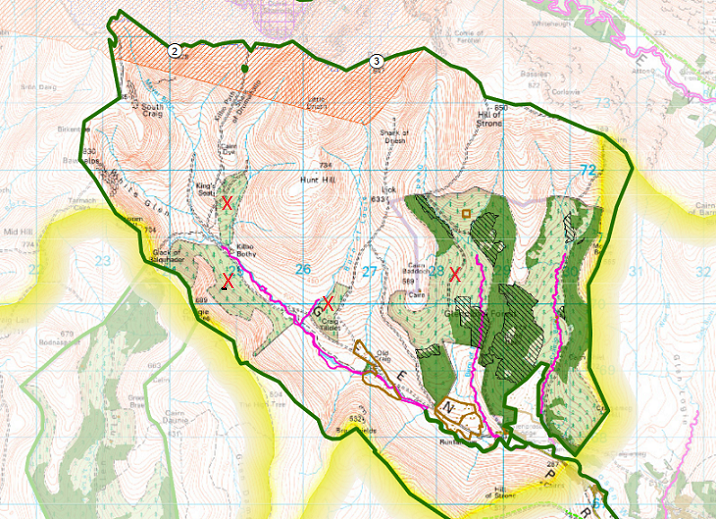
All the light green conifer plantations appear to have been clearfelled though this is not explained in the map key (I have photos for those marked X):
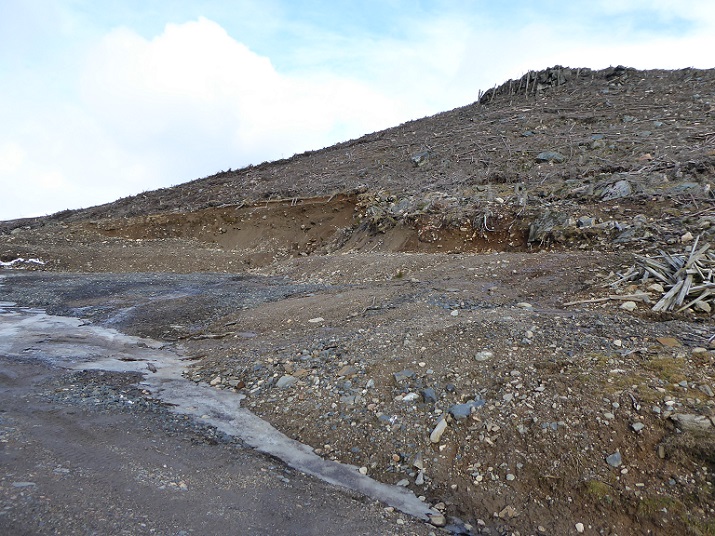
Much of the remaining plantation has been windthrown (the hashed sections of the dark green). What thoughts FLS has about why the windthrow happened and how to avoid this happening in future is not explained. Nor are the options for what to do with it or how to restore the felled areas. All are fundamental questions for any future “forestry” or re-wilding here so why the silence in the consultation?
If FLS has changed the way the land in Glen Prosen is managed since it bought it, you wouldn’t know. A year ago I highlighted a number of things that could be done immediately (see here): an immediate end to muirburn; the removal of all traps (for photos and commentary see here); a reduction in deer numbers through culling. These are simple things to do. FLS may well have done them but if so, you wouldn’t know from the consultation.
FLS’ plans for Glen Prosen
Easy to miss at the end of the consultation webpage, the section “Learn more about the Angus Glens” does include some information about the properties FLS bought but is really about their intentions.

The Angus Glens FAQs reveals some of FLS intentions in respect of how the land will be managed:
- It suggests that the focus will be on re-wilding according to what it calls the Scottish Government’s definition of that term, but not how this will be done e.g whether fences will be used or what it will do with the plantations that are still standing;
- It says it will reduce deer numbers but only in consultation with neighbouring estates when we know that deer have to be reduced to 2 per square km for natural regeneration to take off;
- It indicates that it may try and used carbon credits to finance the project.
Which brings us to the elephant in the room, money. FLS has failed to say what budget, if any, is available to finance the management of Glen Prosen.
The other tab under “Learn More about the Angus Glens”, headed “Glen Prosen: exciting opportunities for communities and business” is very revealing in this respect.
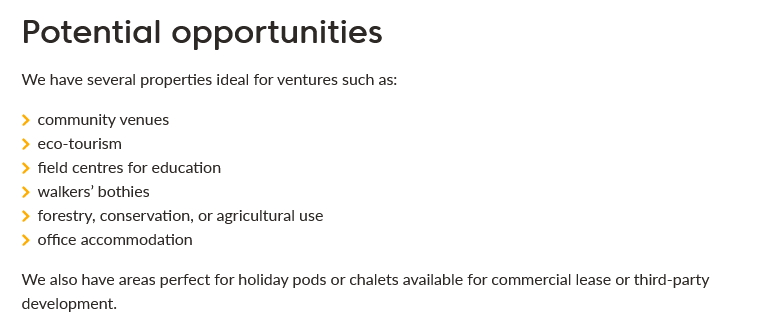
What is not said is how many properties FLS believes it needs itself for managing the land or for staff (e.g deer larder and accommodation) but in the absence of information to say otherwise it appears FLS is trying to lease much of it out commercially. For example, there are descriptions of three “holiday cottages” which “are available for commercial lease or development. They can be leased together or individually depending on expressed interest and availability.” In other words FLS needs to generate money to finance the “project” – it is still not clear if FLS bought the hydro scheme as part of the sale and if so how much income that might generate.
One of these “holiday houses” is described as the “head keeper’s house” which suggests that FLS has no plans to employ resident deer stalkers or foresters. If so, it appears FLS is going to apply the same disastrous model to Glen Prosen as its done elswhere, where its land is “managed” by staff in far away offices, work is undertaken by contractors coming in from outside and other assets are leased out to private organisations to make profits (see here).
If Glen Prosen is going to be a regenerative project that includes people, following the Scottish Government’s definition of re-wilding, then the consultation should have started with an explanation of the number of people who had been employed by the previous owners, set out how many jobs FLS proposed to create in the glen and then asked what else they could do to support job creation. It hasn’t, but instead is continuing with the market free for all that has stripped remote glens of their population.
People should not be fooled by the five local consultation events which were scheduled as part of the consultation which on the face of it provided lots of opportunity for the 120 people resident in Glen Prosen and Glen Clova to become involved. With FLS having completely ignored the Aviemore and Glenmore Community Trust on the future of the Glenmore campsite, why would they respect the views of people living in the Angus Glens?
What needs to happen
I hope people will consider responding to FLS’ consultation (see here – open till 12th) and make the point FLS needs to change.
Ten months after I set out “What the Scottish Government should ask FLS to do NOW at Glen Prosen” (see here), FLS haven’t even got started!
To assist anyone thinking about responding, I think its worth repeating in full the points I made in January:
“Formulating plans may take time, but it also requires transparency, and with the climate and nature emergencies our public authorities need to be taking immediate action where possible. FLS could deliver the following within the next month if they had the will:
- Issue information publicly about what has been bought (e.g. the number of properties included in the land sale), any conditions which could impact on future land-management (e.g there appears to be what is a sporting enclave with rights of access) and the main liabilities (e.g. the damage caused by previous track construction) – all questions which I drew attention to in my post in October (see here).
- Clarify how many staff lost their jobs/houses as a result of the sale and what actions have been taken to redress this (the parliamentary exchange suggests one former member of staff has been offered part-time employment by FLS).
- Remove ALL wildlife traps from the estate (see here), if this has not been done already.
- Stop all muirburn with immediate effect
- End all sheep grazing outside fenced enclosures and commit to challenging neighbouring landowners who allow sheep to wander onto their land
- Commit to reducing deer numbers to a maximum of 2 per square kilometre, which we know is the level which allows natural regeneration to take off, within three years and create stalking jobs to deliver this.
- Commit to working publicly with the Cairngorms National Park Authority to ensure future management of the Glen Prosen estate delivers National Park objectives and is used to put pressure on neighbouring landowners to change how they manage their land.
I attended the Memus consultation event . The staff seemed rather clueless and the whole proposal was wishy washy with no firm targets or focus .
Back in the 1980’s the National Audit Office declared the then Forestry Commission to be a very expensive job creation scheme, or words to that effect. The enduring culture of non entrepreneurial thought pervades to this day. Choosing to plant genetically modified non native trees which have shallow roots and are thus vulnerable to windthrow when planted on elevated and thereby vulnerable sites is about the best they can come up with, and then sit back, polish the office seat, and watch them grow on the computer screens as the pension draws nearer. The state of the country is Forrest’s need to be properly audited, for harms inflicted on riparian habitats as well as forest floor, their activities are depleting both the soil and water qualities, and all that depend on same. They absolve themselves of this rack of responsible stewardship, citing their ‘need’ to deliver useable timber to the processor yards, yet anyone taking even a casual look at any European forests can only marvel at the levels of mismanagement here in Scotland. Worse yet, the number of rural jobs they support these days scarcely justifies the externalities and cost to the public purse, and rather like the now also largely automated yet equally troubled salmon farming industry, specialises in polluting our natural heritage in pursuit of ‘profits’ from a toxic and largely harmful end product.
So! Here ye are, wi’ bricht new plans
Tae re-arrange the wid
An’ sell yersels as “Eco-fans”
Tae better ply yer bid
Yet
fan I keek ‘round the muckle wids
Shortcomin’s, I see there,
An’ It’s only noo ye think it rash
Tae spile the hills some mair!
Aye, pure despoilment’s aa’ there’s been
Richt up tae nae lang seen,
Neglectin what ye should hae dane
Aroun the wid, my frien’;
For near exhausted is the yird
An’ the Public purse forbyes
An’ scarce remains a game-lik’ bird
Whaur the sitka needle lies;
Just twenty year, is aa’ it’s tane
For sic a change tae come,
Fae num’rous stock, tae few they’ve gane
Aa’ by the “Work” o’ Some;
The Caper-cock is aa’ but lost
Through pure mismanagement
Denied they are o’ nat’ral host
By Greed o’ men, Hell-bent,
On plantin’ methods o’ ill choice,
Denyin’ groun’ the licht,
Wi’ nae a berry-seed o’ choice
Tae see him thro’ the nicht.
An’ blackcock- grouse an’ mottle hen
Disturbance winna stan’,
An’ fae oor lan’ expire again
At Mankin’s greedy haun’.
Their hairstin’ toy, ye’ll hear it moan,
Aa’ day, an’ half the nicht,
Wi fearfu’ racket, rummlin’ on,
An’ kern o’ flashin’ licht;
If ye were nestin’ in that airt
Wi’ aa’ that licht & soun’,
Ye’d like-wise certainly seen pairt
Ere vexin’ row deed doun.
Tho’ aa’ can see, whaur they’re employed
The wildlife’s lost desire;
– Their habitat has been destroyed
An’ situation dire
Tae cap it aa’ – they mak’ a loss
An’ for aa’ this, we pay,
Whil’ “Clever men” wi’ timmer-dross
In God-lik’ style div play!
But yet, They’re meant tae gie tae us
Bio- Diversity!
Well, ‘Talk is cheap’ upo’ their bus,
For noo, best wait an’ see….
Aye!
We “Pay the Piper “ in this case,
But He decides the tune,
Wi’ “Expert” haun’ the hills he’ll grace
The harmfu’ timmer roun’
An’ roun the Mairch the peezie begs
An’ grouse lament their loss
– The black wid-craws tak aa’ their eggs
An ye dinna gie a toss;
For surely, better, it wad be
Tho’ loss it made as weel,
A wid-environment tae see
That left aa’ wildlife weel?
An’ the whaup –she disnae fit weel in
O’ yer ‘Forest System’ here:
The wid tod gaithers her poults in:
-“ It’s Tough Luck ye’re having, dear!”
The problem sure, here is, forsooth
Is nane o’ Them clear sees
The Bigger Picter o’ the truth
O’ the widdie, – for the trees!
Nah!
They’d try tae tell us it’s the weet
That’s killed the population;
But since they’ve felt the ‘Vermin’s’ feet
They’ve suffer’d decimation
And –
The troots, o’ burnie waters clear
Hae lang since been denied,
Wi’ acid trees fae nae ow’r here
The plantin’ has been tried;
Yet damn a finger will They raise
Tae ease their plight this day;
Preferring “Expert” chiels tae praise,
Whilst watchin’ them decay
Aye,
This twenty year the “Water-Rules”
Hiv socht tae licht the way,
Yet aye, upo’ this “Ship of Fools”
They’re qwetly fil’d away.
An’ aa’ because the powr’s that be
They winna heed advice
Fae emin-ent lads that can see
Nae virtue in their vice.
For they rely on subsidy,
Paid by the public purse,
Bit Humsa’ thinks he’d seener gie
Tae Bobby, or tae Nurse.
But as they say at their HQ
“Now now, just let it rest!
Its verra clear – ‘the chosen few’ –
Us “Foresters” ken best!
Aye, seen, when Simple Truth comes oot,
Nae mair ‘twill be sae gran’
Fan they fin’ they must dae withoot
Misguided helpin’ haun’.
An’ whit-matter that they waste awa
Oor natural treasures here?
In Inverness’s fancy Ha’
They’re fairly heard tae cheer:
“What lads we are, sic clever chiels
We’ve saved the Clash for sure –
Nae mair need for Sitka -, Wir
Green credentials now secure!”
– Gloss o’er our past incompetence
this forty year gane bye,
– We’ll offer up a new pretence
An’ hae anither try;”
“It daesnae metter if we mak
The changes ootlin’d here:
The local fowk, nae punch will pack
Efter a twa-three year”
“Aye!
What lads we are, sic clever chiels
Tae offer up this plan,
An’ thus subdue thae Native Feels
Fae wir braw new tow’r sic gran’!”
“As lang as we’ve wir jobs, ye see
The wid will be jist gran’,
An’ we can play at fit we dae
Wi’ wir braw new Maister-plan!”
“Aye!, Fit wad they ken? They’re but feels
That hinna got a clue:
Nah! We’re the Forest-Expert chiels
That know a thing or two!”
And so, these ‘Wordy, worthless loons
Will keep their jobs, an’ try,
A-richtin aa’ the wrangs they’ve made,
This forty year gane by.
An’ aa the while, they’d kid themsel’s
They’ve found the best wye roun’
Tae stifle aa’ their critics’ yells
An’ haud the ‘natives’ doon!
An We, the fowk that pay their wage
– Real gratefu’ we maun be,
Tae hae sic ‘expert’ lads at haun’
Tae ‘manage’ ilka tree
-Noo some micht think it queer, the wye
They keep their jobs here still,
But – Sic’s aye the wye its ever been,
An aye it ever will.
Too bad the locals hiv nae say
On day-to-day affairs
For that wad risk them lose their pay
Tho’ ‘twad answer aa’ oor prayers!
Aye, The time his come for us tae hae
Co-operative schemes,
Ye’d best be hearin’ fit we’ve tae say
– Nae chasin’ jist your dreams!
An’ mebbe syne, wir nyavin doots
Micht some assuagit-be
An spare wir Caper, an’ wir troots
Fae their current misery;
An fa kens? If we got on real weel
The tod micht get his dues,
An’ spare wir chuckens fae his meal
Or the lammies him ‘amuse’;
For We bide here, wi’ wives an’ bairns,
An’ Yer “wark” affects us aa’
So please, tak’ note o’ oor concerns,
Aye, be they big or sma’.
An’ gie’s wir say in layin’ doun
The plans for ‘Better Days’
We ken fit’s nocht the widdie’ roun,
– An syne: we’ll sing yer praise!
You’ve caused me to check the NAO report of 1986. They noted that £2.2bn had been spent between 1946 and 1984. But whole estate was only valued at £1.5bn.
The latest Sitka spruce is genetically improved, I don’t think any genetically modified trees exit.
The ‘reforms’ to the public agencies responsible for forestry and natural heritage in Scotland in recent years appear to have left them singularly ill-equipped to tackle the challenges they face.